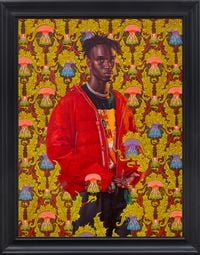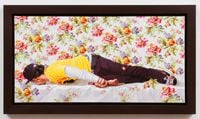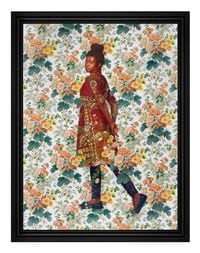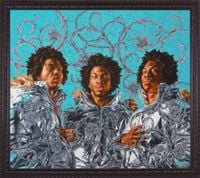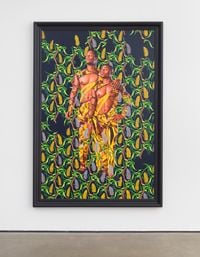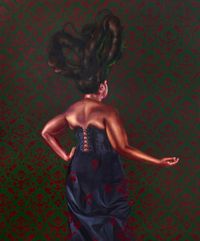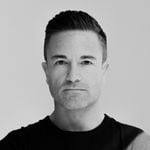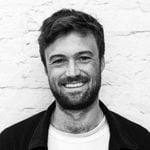For painter Kehinde Wiley, realism is a form of subversion. Known primarily as a portraitist, he draws from Western art history—particularly Renaissance, Dutch Golden Age, Baroque, and Neoclassical painting—to examine themes of race, class, gender, and power.
Read MoreKehinde Wiley's portraits draw attention to the representation of race and gender in art, stressing the absence of black figures in the history of Western portraiture.
His works depict contemporary brown and black sitters, ranging from strangers he met on the streets to well-known personalities like soccer stars Samuel Eto'o, John Mensah, and Emmanuel Eboué; musicians Michael Jackson and Notorious B.I.G.; and even the 44th president of the United States, Barack Obama, whom he was commissioned to paint for the National Portrait Gallery in Washington, D.C., in 2018.
Wiley began painting his signature portraits in 2001, while residing in New York as part of a residency at the Studio Museum in Harlem that involved inviting strangers he encountered on the streets back to his studio.
Imitating selected postures from historical paintings, his models posed for photographs that he would use to make his paintings. As a foil to the common association of young African American men with violence and antisocial behaviour in American popular culture, his larger-than-life portraits celebrate the sitters' youth, stature, and status within their communities.
Among the most iconic of Wiley's portraits is Napoleon Leading the Army over the Alps (2005), based on Jacques-Louis David's equestrian portrait First Consul, crossing the Alps at Great St Bernard Pass, 20 May 1800 (1803).
In his version, Wiley replaces Napoleon and his 19th-century military regalia with an anonymous black man dressed in a bandana, cargo pants, and Timberland boots. Behind the figure, the grand Alps becomes a decorative background rendered in a colour palette of red and gold.
Tiny sperm were also included as relief forms in the frame—a satire on the tradition of propagating masculine power and privilege in Western portraiture through devices such as equestrian figures and military gear. Napoleon Leading the Army over the Alps belongs to 'Rumors of War' (2005), a painting series that focusses on equestrian portraits.
Due to the increased demand for his paintings, which are often several metres tall and densely ornate, Wiley works with a team of assistants—a studio system that hails back to the days of Renaissance artists such as Michelangelo and Rubens, further extending the artist's appropriation of canonical art forms and modes of working.
In 2006, the artist opened another studio in Beijing after visiting a friend there and finding himself drawn to the city for its distance from New York.
Wiley, along with Amy Sherald, became the first African American artists to paint the official portraits for a President or First Lady of the USA with their portraits of Barack and Michelle Obama in 2018. Commissioned by the National Portrait Gallery, Wiley's President Barack Obama shows the former USA president seated in a chair, surrounded by green foliage and flowers that symbolise a portion of Obama's life.
The painting has since attracted thousands of visitors to the gallery, and in 2021 The Obama Portraits Tour travelled to seven cities from Chicago to Boston, returning to Washington, D.C., in November.
Since 2007, Wiley has extended his street casting globally with the series 'The World Stage' (2007–ongoing), for which he travels to different countries—including Brazil, France, Haiti, Jamaica, and Sri Lanka—and asks young black and brown people living there to model for him.
In the paintings belonging to this series, his characteristic brightly coloured backgrounds are adorned with motifs borrowed from different visual cultures. For example, West African kaftan, which are known for their often colourful and complex designs, inspired the intricate backgrounds in the 'Lagos & Dakar' (2008) paintings, while the architectural form in the portrait Alios Itzhak from 'Israel' (2011) is derived from a Jewish decorative plaque known as mizrah.
The history of each sitter's country also influenced their poses as in the historic propaganda posters from the Cultural Revolution that inspired 'China' (2007). One painting from the series, Celebrating with Great Joy and Enthusiasm the Publication of the Constitution of the People's Republic of China (2007), shows a young man dressed in hip-hop-style attire lifting a bundle of lilies over his head, a composition based on a poster in which a young woman similarly holds flowers before red flags.
As part of his growing range of represented subjects, Wiley has begun to depict women. The series 'An Economy of Grace' (2012) consists solely of portraits of African American women wearing custom-made couture gowns (created by the Italian fashion designer Riccardo Tisci) against brightly coloured floral backgrounds.
The paintings are similar in composition to historical portraits featuring female subjects by European painters. Juliette Recamier (2012), for example, depicts an African American woman reclining on a long sofa and is based on David's Madame Récamier (1800).
Two paintings in the series, titled Judith and Holofernes and Judith Beheading Holofernes (both 2012), reference the biblical story of Judith, in which Judith lures an adversary into her tent to behead him. A popular subject in European art history, numerous artists, including Caravaggio and Artemisia Gentileschi, have represented this story. In Wiley's treatment, a black woman with a knife holds the severed head of Holofernes, depicted as a white woman.
In 2018, in light of the unveiling of his Obama portrait at the National Portrait Gallery, The North Carolina Museum of Art promoted Judith and Holofernes (which it had purchased in 2012) for viewing, and the artwork received some backlash from viewers who regarded it as racist.
Beyond portraiture, Wiley also examines the Western tradition of sculpture.
The artist first worked with sculpture in 2006 for his collaboration with Cerealart in Philadelphia, creating three busts in cast marble and resin. They depict young black men dressed in contemporary clothes, with their postures based on Baroque and Renaissance artworks including the Italian sculptor Bernini's Bust of Louis XIV (1665) and French artist Jean-Baptiste Carpeaux's Why born a slave! (1872).
In September 2019, Wiley unveiled his first public artwork in titled Rumors of War (2019): an equestrian statue of a young black man conceived in response to various Confederate monuments in the United States. After its debut in Times Square, New York, it was permanently installed in the Virginia Museum of Fine Arts in 2020.
Wiley's solo exhibition An Archaeology of Silence at de Young Museum, San Francisco (2023) revisits the iconography of death in Western art, reflecting on the police killings of Black people in recent years and the worldwide rise of the Black Lives Matter movement. Among the new large-scale paintings and sculptures is a 2021 bronze sculpture that lends its name to the exhibition, depicting the body of a young man draped over a horse.
Wiley's paintings are in the permanent collections of The Metropolitan Museum of Art, New York; the Studio Museum in Harlem, New York; the Los Angeles County Museum of Art; the Walker Art Center, Minneapolis; and the Brooklyn Museum, amongst other institutions.
A celebrated painter of his generation, Kehinde Wiley has exhibited widely around the world in gallery and museum shows.
Select solo exhibitions include Kehinde Wiley: An Archaeology of Silence, de Young Museum, San Francisco (2023); Colorful Realm, Roberts Projects, Los Angeles (2023); Sunley Room, National Gallery, London (2021); Jacques-Louis David Meets Kehinde Wiley, Musée national du château de Malmaison, Rueil-Malmaison, France, and Brooklyn Museum, New York (2019–2020); Kehinde Wiley: Saint Louis, Saint Louis Art Museum, Missouri (2018).
In 2015, the Brooklyn Museum in New York hosted a major solo exhibition of his work, titled A New Republic. The exhibition toured to four other museums, including the Modern Art Museum of Fort Worth, Texas; the Seattle Art Museum; the Virginia Museum of Fine Arts; and Phoenix Art Museum. At the Seattle Art Museum, the opening-day attendance broke records with more than 2,800 visitors.
Select group exhibitions include Memling Now, Sint-Janshospitaal, Musea Brugge, Brussels (2020); Icons: Worship and Adoration, Kunsthalle Bremen, Germany (2019); Michael Jackson: On The Wall, National Portrait Gallery, London, and Grand Palais, Paris (2018); You go to my head, Galerie Templon, Paris (2016); Versus Rodin: Bodies across space and time, The Art Gallery of South Australia, Adelaide (2016).
Kehinde Wiley's website can be found here and his Instagram can be found here.
Sherry Paik | Ocula | 2023
